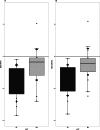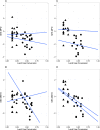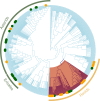Increasing land use drives changes in plant phylogenetic diversity and prevalence of specialists
- PMID: 26966669
- PMCID: PMC4782714
- DOI: 10.7717/peerj.1740
Increasing land use drives changes in plant phylogenetic diversity and prevalence of specialists
Abstract
Increased human land use has resulted in the increased homogenization of biodiversity between sites, yet we lack sufficient indicators to predict which species decline and the consequence of their potential loss on ecosystem services. We used comparative phylogenetic analysis to (1) characterize how increasing conversion of forest and grasslands to grazing pasturelands changes plant diversity and composition; (2) examine how changes in land use relate to declines in functional trait diversity; and (3) specifically investigate how these changes in plant composition affect the prevalence of zygomorphy and the possible consequences that these changes may have on pollinator functional groups. As predicted, we found that the conversion to grazing pasturelands negatively impacted species richness and phylogenetic composition. Clades with significantly more represented taxa in grasslands (GL) were genera with a high representation of agricultural weeds, while the composition was biased towards clades of subalpine herbaceous wildflowers in Mixed Forest (MF). Changes in community composition and structure had strong effects on the prevalence of zygomorphic species likely driven by nitrogen-fixing abilities of certain clades with zygomorphic flowers (e.g., Fabaceae). Land conversion can thus have unexpected impacts on trait distributions relevant for the functioning of the community in other capacities (e.g., cascading effects to other trophic levels (i.e., pollinators). Finally, the combination of traits represented by the current composition of species in GL and MF might enhance the diagnostic value of productivity and ecosystem processes in the most eroded ecosystems.
Keywords: Functional diversity; Phylogenetic community structure; Pollinator specialization; Trait composition.
Conflict of interest statement
Jana C. Vamosi is an Academic Editor for PeerJ.
Figures




Similar articles
-
Land-use type and intensity differentially filter traits in above- and below-ground arthropod communities.J Anim Ecol. 2017 May;86(3):511-520. doi: 10.1111/1365-2656.12641. Epub 2017 Feb 28. J Anim Ecol. 2017. PMID: 28118484
-
Land-use impacts on plant-pollinator networks: interaction strength and specialization predict pollinator declines.Ecology. 2014 Feb;95(2):466-74. doi: 10.1890/13-0436.1. Ecology. 2014. PMID: 24669739
-
Patterns of plant diversity loss and species turnover resulting from land abandonment and intensification in semi-natural grasslands.J Environ Manage. 2018 Jul 15;218:622-629. doi: 10.1016/j.jenvman.2018.04.059. Epub 2018 Apr 30. J Environ Manage. 2018. PMID: 29715671
-
Interactive effects of climate and land use on pollinator diversity differ among taxa and scales.Sci Adv. 2022 May 6;8(18):eabm9359. doi: 10.1126/sciadv.abm9359. Epub 2022 May 6. Sci Adv. 2022. PMID: 35544641 Free PMC article.
-
Effects of air pollution on ecosystems and biological diversity in the eastern United States.Ann N Y Acad Sci. 2009 Apr;1162:99-135. doi: 10.1111/j.1749-6632.2009.04153.x. Ann N Y Acad Sci. 2009. PMID: 19432647 Review.
References
-
- Adams BW, Stone C, Alexander M, Lawrence D, Willoughby M, Moisey D, Hincz C, Burkinshaw A, Carlson J, France K. Range health Assessment for Grassland, Forest and Tame pasture. 2009. Public Lands and Forests Division, Alberta Sustainable Resource Development. Pub No. T/044.
-
- Adderley LJ, Vamosi JC. Species and phylogenetic heterogeneity in visitation affects reproductive success in an Island system. International Journal of Plant Sciences. 2015;176:186–196. doi: 10.1086/679617. - DOI
-
- Alberta Monitoring Institute (ABMI) Scope and application of the ABMI’s data and information. 2014. Available at http://www.abmi.ca/home/data/welcome-data-portal.html .
-
- Allan E, Manning P, Alt F, Binkenstein J, Blaser S, Blüthgen N, Böhm S, Grassein F, Hölzel N, Klaus VH, Kleinebecker T, Morris EK, Oelmann Y, Prati D, Renner SC, Rillig MC, Schaefer M, Schloter M, Schmitt B, Schöning I, Schrumpf M, Solly E, Sorkau E, Steckel J, Steffen-Dewenter I, Stempfhuber B, Tschapka M, Weiner CN, Weisser WW, Werner M, Westphal C, Wilcke W, Fischer M. Land use intensification alters ecosystem multifunctionality via loss of biodiversity and changes to functional composition. Ecology Letters. 2015;18:834–843. doi: 10.1111/ele.12469. - DOI - PMC - PubMed
LinkOut - more resources
Full Text Sources
Other Literature Sources
Research Materials

